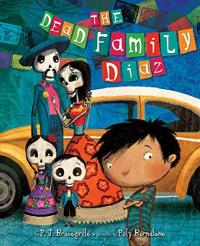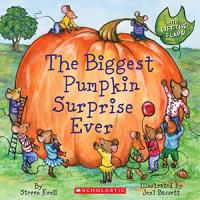
Señor Calvera is back! This time, he is looking forward to Grandma Beetle’s birthday party — but he can’t figure out what gift to give her. He consults with Zelmiro the Ghost and chooses one gift for every letter of the alphabet: acordéon, bigotes, cosquillas (accordian, moustaches, and tickles). It isn’t until he reaches the letter Z, however, that Señor Calvera finds the best gift of all for Grandma Beetle.
Just In Case: A Trickster Tale and Spanish Alphabet Book

The Tortilla Factory

Grouch, Grump, and two-headed little Gloom ‘n’ Doom — three crabby monsters — tried to create the “biggest, baddest monster EVER!” When the huge monster comes alive his first words are “Dank you!” causing the cantankerous little monsters to succumb to his kind ways. Cartoon line and wash illustrations and understated text present a pleasing monster saga.
The Monsters’ Monster

Madcap illustrations bring hilarious new life to the 1962 song, “Monster Mash.” It all begins with a bulbous scientist “working in the lab late one night” when his monster arose from his slab and begins to dance the monster mash. Other monsters — and finally two human children — join the green Frankenstein-like critter for colorful, frenzied fun.
Monster Mash

On Halloween night, children dress up in costumes to go trick or treating. Young children will enjoy guessing what outfit the child is donning, beginning with a rhyming clue which is solved with a turn of the page. Cozy illustrations are just right for this not-very-scary Halloween tale, sure to engage younger children.
It’s Halloween Night!

A trick-or-treater leaves the city for a forest of bones and a deliciously creepy Halloween adventure. No number of skeletons can scare this child who shakes his own bones and is rewarded after he chants, “Trick or treat! Smell my feet! Give me something good to eat!” Lively illustration adds detail to the rhythmic text, ideal for reading aloud.
Halloween Forest

Nothing suggests Halloween like a picture of a fierce or funny Jack-o-lantern, a sky full of bats or ghosts. What would a Halloween night be without a witch, a haunted house or a graveyard? Readers can create these and other signs of the celebration line by line, perhaps individualize them, and read other “spook-tacular books”.
Ralph Marsiello’s Halloween Drawing Book

This silly-spooky parody of Ludwig Bemelman’s Madeline (opens in a new window) emulates the original’s cadence, storyline and illustration but with a decidedly Halloween-y twist. It begins, “In a creepy old castle/all covered in spines/lived twelve ugly monsters in two crooked lines… The ugliest one was Frankenstein.” It is sure to amuse even those not familiar with the original.
Frankenstein: A Monstrous Parody

Angelito Diaz along with his skeleton family celebrates the Day of the Dead in the Land of the Living — and he was scared. Angelito isn’t nearly as frightened after he meets Pablo — and overcomes his fear of the living. Colorful, stylized illustrations and a brief note about the Mexican Day of the Dead/El Dia los Mueros conclude this recognizable story.
The Dead Family Diaz

Mice prepare to celebrate Halloween, first by finding pumpkins, using them for decorations, and finally unveiling a huge Jack-o-lantern! Festive illustrations on sturdy pages encourage close examination and active participation as children lift flaps to reveal hidden surprises.
Biggest Pumpkin Surprise Ever

Boo, the smallest in his ghost family, enjoys the first time he’s allowed to stay up late whistling a “happy-ghost-lucky time.” He doesn’t think he can sleep until his wise mother helps him listen for comfy night sounds. Soft lines and gentle forms illustrate the gently rhyming onomatopoetic language for a mellow, non-scary Halloween story for younger children.
Bedtime for Boo

Meet Marisol McDonald, a spunky young girl with fiery red hair and brown skin who wears green polka dots with purple stripes, mixes English and Spanish, and eats peanut butter and jelly burritos. Everyone tells her she doesn’t match, until one day she tries matching — and discovers that it makes her miserable. At the end of the day, however, her teacher shares a special secret with her and lets her know she likes Marisol for who she is: a creative, bilingual Peruvian-Scottish-American! This poignant story, based on Monica Brown’s childhood, celebrates each individual’s uniqueness and reminds children that it’s ok not to fit into boxes that other people may put you into. Bilingual text.
Marisol McDonald Doesn’t Match/Marisol McDonald no combina

Meet Clara, a little girl who is very, very grumpy. Mami is tired of Clara’s grumpy face, so she sends her daughter to the curandera — or healer — down the hall. The curandera knows just what Clara needs — to help her neighbors! Readers will cheer for Clara as she learns to focus on others rather than herself in this charming story.
Clara and the Curandera

Chavela loves chomping chicle — chewing gum and blowing bubbles. One day, while out with her abuelita, she finds a mysterious kind of gum she has never seen before. She pops it in her mouth and blows a giant bubble that lifts her up into the air and carries her on a magical journey. Candy-colored paintings illustrate this fantastical story with an ecological twist. An afterword provides information on natural chewing gum, the rainforest, and sustainable farming, as well as music to a traditional Latin American folksong.
Chavela and the Magic Bubble

Julianita is excited to receive her very own caterpillar to raise at school! Yet when her caterpillar, Tiger, finally emerges from his chrysalis, Julianita doesn’t want to let him go. She worries that he will get lost on his way to Mexico. “Tiger knows the way to Mexico because it’s in his heart,” her Abuelito reassures her. She feels sad to see Tiger fly away, but Julianita knows that someday, she will follow him to back to her grandfather’s beloved homeland.
Butterflies on Carmen Street

Rocket, the small dog (How Rocket Learned to Read (opens in a new window)), loves words and wants to use them in a story. His teacher — a patient yellow bird — helps Rocket write. Not only does Rocket write (and revise) a story, he finds a friend. Concrete strategies for successful writing are presented with a light and always appealing touch.
Rocket Writes a Story

What happens when pirates and their parrots go to school? Aargh! They learn to follow rules (like cleaning up their messes and enjoying story time) just like the regular kids in class. Wacky, exaggerated illustrations combine with the rhyming tale for a funny romp and different take on a typical school day.
Pirates Go to School

Children share Ollie’s school day beginning with getting dressed for school (will he wear a bathing suit? A space suit? A police officer’s uniform? Shirt and pants?) as well as everyday activities until the he gets home. Young listeners will laugh as they participate in this inviting, comical, and lively presentation.
Ollie’s School Day: A Yes-and-No Book

Newly independent readers will figure out the riddles (culled from other books in the “I Spy” series) and enjoy locating the objects. Words and photographs on one side of each double page spread provide clues for decoding as well as what to look for in the more intricate photographic scene on the opposing page.
I Spy: School

When the story-loving small white dog – the owner of a bookstore (first introduced in Dog Loves Books (opens in a new window)) — receives a blank book, he’s puzzled. Inside, there’s a note from Dog’s aunt saying that “the lines [Dog] draws open a door to some wonderful adventures.” His imagination and creativity sparkle as Dog tells a story with line and color. Dog’s engaging story within a story is sure to inspire art and artists.
Dog Loves Drawing

Upper and lowercase letters worry that Mr. Wright’s students no longer know when to use capitalization! A student letter to the principal about Teacher Appreciation Day is all wrong, prompting the small letters to send an SOS (Save Our Sentences). The kids (and readers) learn when to capitalize and a bit of letter history in this bright, humorous classroom tale.
The Case of the Incapacitated Capitals

Autumn is a season during which there are many changes: leaves turn colors, air becomes cooler, and crops are harvested. These and more seasonal signals are presented in conversational language and vivid photographs. Easy-to-do autumn activities conclude this attractive and appealing book.
Awesome Autumn

A spiffy fox and friends and the alphabet are used to introduce apples — from blossoms, to how they grow, apple varieties, and more. Rich words (such as “deciduous”) are used, briefly but effectively introducing sophisticated concepts. Back matter extends the fun, activities, and information.
Apples A to Z

Single words in apple red combine with bold black-lined illustrations to tell tales of apples, autumn, seasons, and more. A brief note about apple trees and composting conclude this unique and attractive look focused around one of fall’s favorite fruits.
